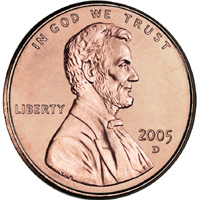Cent (unit of currency): Difference between revisions
Jump to navigation
Jump to search
imported>Anthony Argyriou (Create from Cent (British Commonwealth) and add content) |
imported>Anthony Argyriou (minor edits, add image) |
||
| Line 2: | Line 2: | ||
The cent is a subunit, equal to 1/100 of the primary unit, of the following monetary units: | The cent is a subunit, equal to 1/100 of the primary unit, of the following monetary units: | ||
[[Image:2005PennyObv.jpg|thumb|right|200px|One cent coin from United States]] | |||
* [[Australian Dollar]] | * [[Australian Dollar]] | ||
* [[Bahamian Dollar]] | * [[Bahamian Dollar]] | ||
* [[Barbados Dollar]] | * [[Barbados Dollar]] | ||
* [[Belizean Dollar]] | * [[Belizean Dollar]] | ||
* [[ | * [[Bermudan Dollar]] | ||
* [[Bruneian Dollar]] | * [[Bruneian Dollar]] | ||
* [[Canadian Dollar]] | * [[Canadian Dollar]] | ||
| Line 80: | Line 80: | ||
{| class=wikitable | {| class=wikitable | ||
|- | |- | ||
!centime!!centavo | !centime!!centavo | ||
|- valign=top | |- valign=top | ||
| | | | ||
Revision as of 18:11, 26 June 2007
The cent is a unit of money in a large number of countries, always signifying one hundrednth of the basic monetary unit. The word cent is derived from the Latin centum, meaning "hundredth".
The cent is a subunit, equal to 1/100 of the primary unit, of the following monetary units:
- Australian Dollar
- Bahamian Dollar
- Barbados Dollar
- Belizean Dollar
- Bermudan Dollar
- Bruneian Dollar
- Canadian Dollar
- Cayman Islands Dollar
- Cocos (Keeling) Islands Dollar
- Cook Islands Dollar
- Cypriot Pound
- East Caribbean States Dollar
- Eritrean Nakfa
- Estonian Kroon
- European Union Euro (adopted by 13 of the EU member nations)
- Fijian Dollar
- Guyanese Dollar
- Hong Kong Dollar
- Principality of Hutt River Dollar
- Jamaican Dollar
- Kenyan Shilling
- Kiribati Dollar
- Liberian Dollar
- Maltese Pound
- Mauritian Rupee
- Namibian Dollar
- New Zealand Dollar
- Pitcairn Islands Dollar
- South African Rand
- Seychelles Rupee
- Singaporean Dollar
- Sierra Leone Leone
- Solomon Islands Dollar
- Somaliland Shilling
- Sri Lankan Rupee
- Surinam Dollar
- Swaziland Lilangeni
- New Taiwan Dollar
- Tanzanian Shilling
- Trinidad and Tobago Dollar
- Tuvaluan Dollar
- Ugandan Shilling
- United States Dollar
- Zimbabwean Dollar
The following obsolete currencies have also had a subdivision named the cent. In all cases, the cent was 1/100 of the primary unit.
- British Caribbean Territories (Eastern Group) Dollar
- British Guiana Dollar
- British Honduras Dollar
- British North Borneo Dollar
- Chatham Islands Dollar
- Cingalese Rupee
- Cocos (Keeling) Islands Rupee
- East African and Ugandan Rupee
- East African Florin
- East African Shilling
- Malayan Dollar
- Malayan and British Borneo Dollar
- Mauritian Dollar
- New Brunswick Dollar
- Newfoundland Dollar
- Nova Scotian Dollar
- Penang Dollar
- Prince Edward Island Dollar
- Rhodesian Dollar
- Sarawak Dollar
- Sealand Dollar
- Sierra Leoneian Dollar
- Straits Settlements Dollar
- Zanzibari Rupee
In other languages
Currencies used primarily in non-english-speaking countries often have similar names derived from centum; these include the French centime and the centavo, used in several Spanish and Portuguese speaking countries.
| centime | centavo |
|---|---|
|
